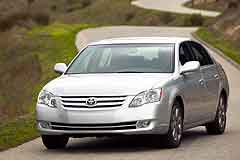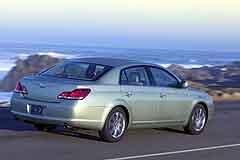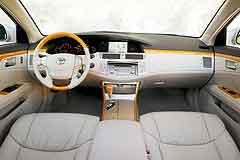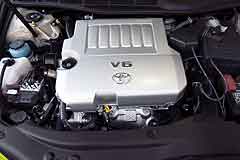New Car Review of the 2005 Toyota Avalon Full-Size Sedan

Base MSRP Range: $26,350 - $33,540
Base Invoice Range: $23,543 - $29,514
Options & Features
Price Quote
New Car Prices
Used Car Prices
Payment Calculator
Rebates & Incentives
Trade In Values
Find A Dealer
Financing
Insurance Rates
Sell Your Car
MSRP As Tested: Not Available
Versions: Xl, Touring, XLS and Limited.
Vehicle Category: Full-size sedan
Engine Location: Front Engine
Drive Wheels: Front-Wheel Drive.
Standard Engine as Tested: 3.5-liter, Dual Overhead Cam, 24-valves, V-6, 280 -horsepower at 6,200 rpm and 260 lb-ft torque at 4,700 rpm.
Transmission: Four-speed automatic, Five-speed manual.
Fuel Economy (city/hwy): 22/30.
Standard Safety Features: Driver and passenger airbags, Side Curtain Airbags ">, Seat mounted side airbags, Drivers knee airbag, Vehicle stability control , Antilock brake system, Electronic brake force distribution, .
Competition: Nissan Maxima, Ford Crown Victoria, Mercury Marquis, Chrysler 300, Chevrolet Impala, Buick LaCrosse.

Review
The Toyota Avalon has always been the most American-like, Japanese-made vehicle on the market. It is big, heavy, comfortable and very quiet. It is the only full-size, it was the only Japanese car available with a bench front seat. It has been so American for so long that Avalon was dubbed the “Japanese Buick” by the industry.
Launched in 1995, Avalon was designed in the U.S. at the Calty Design and Research Center in Newport Beach, California. It was, and still is, assembled at the Toyota plant in Georgetown, Kentucky, exclusively for the North American market.
In 1995 large sedans were very different than today. Most had ladder frames, like trucks, instead of body-on-frame constructions, like cars. The early Avalon was based on the Camry platform and there was little differentiation between the two products, costing Toyota some sales. Not only did the two cars look similar, both had the same power plant.
Owners loved the car but admitted the styling was bland. They wanted some pizzazz. Avalon owners also wanted a more substantial power plant and better road feel. And they also wanted more amenities as most buyers considered them low-cost luxury cars.
The 2005 Avalon is a full-size, near-luxury car aimed at Camry owners who don’t want to make the leap to a luxury nameplate (for whatever reasons) but who want more room and amenities. Camry was sort of a dead-end for Toyota owners, and Toyota wanted Avalon to be the next step up within the brand for their clients.
The 2005 version is more distinctive looking than the predecessor, and larger everywhere, both inside and out. It is loaded with new technology and features not available in the current Camry. It has 33% more power from a brand new V6 power train. In fact the 2005 Avalon is the first product Toyota has put this new engine in.
Avalon is also is more American than ever. Not only was the car designed in California, and built in Kentucky, it is the first product developed entirely in the U.S. by the Toyota Technical Center (TTC) in Ann Arbor, Michigan. Previously TTC only engineered the platform. This time Toyota left control of the entire project, including the power train and both interior and exterior styling, to TTC. As a result, development time was shortened to 18 months, the quickest of any North American-produced Toyota.
The 2005 Avalon is offered in four grades: the standard XL, the sportier Touring, the well-equipped XLS, and the top-of-the-line Limited.
Exterior
Toyota paid a great deal of attention to input from owners and dealers. As a result the 2005 Avalon’s appearance is much more upscale and stylish. If you saw it parked in the lot of a trendy restaurant, you would think it was Lexus, Acura or Infiniti.
The rounded silhouette is similar to the new Lexus GS sedan. Despite similarities in shape and size, Avalon is not a Toyota version of the GS. Avalon is a front wheel drive car, while the Lexus is rear wheel.
The grille has two large horizontal bars with a large Toyota emblem in the middle. Headlamps and fog lights are together in a single cluster. Avalon has a beltline that runs from the top of the headlights, all the way to the taillights. The roofline is rounded and continues onto the trunk lid, and right into the taillights. It has nice, cohesive line. But while Avalon is definitely sportier and more youthful than it used to be, it is not a sports sedan.

Interior
Avalon’s interior is on par with any near-luxury, mid-size sedan from Acura, Infiniti or sister-brand Lexus. The passenger space is large and open. The design is modern and clean. And the fit and finish is first rate.
The dash cowl is huge, stretching across half of the dashboard. On the left are the analog gauges for the speedometer, tachometer, fuel and temperature. The screen for the navigation, and other systems, is on the right. Heating Ventilation and Air Conditioning (HVAC) vents are below the screen, at the top of the center stack. The entertainment system is just below with a cover to conceal it. The switches for the climate control system are located on either side of the entertainment system. There is a drawer in the front of the center console containing the controls for the information center. The gear selector and cup holders are just in front of that.
The rear passenger compartment is expansive with reclining rear seats -- perfect after a big meal, or on a long haul. There’s loads of leg and shoulder room. The rear floor is flat so three adults sitting in the back can all be comfortable. All this makes the back seat a very desirable place to sit.

Performance
Avalon is powered by Toyota’s all-new, V6 engine. This is the first application of the power train, and it will be used in a number of future products. It is the most powerful V6 ever offered in a U.S. model from Toyota.
The 3.5 liter, dual overhead cam, VVTI, V6 engine develops 280 horsepower at 6,200 rpms and 260 lb-ft of torque at 4,700 rpms. That is 33 percent more power than the previous V6.
Toyota engines are bullet proof. They seem to last forever. The new V6 in the Avalon is likely to be no different. It is so quiet you barely hear it when driving with the windows down. And you don’t hear it at all with the windows up. The power comes on smoothly and it responds well when you stand on the gas for passing. Toyota claims that the 0-to-60 mph times are around 6.6 seconds.
Avalon has an EPA fuel economy rating of 22 city/31 highway miles to the gallon. This is very good for a 280 horsepower engine. And it is clean too as it was targeted for certification as an Ultra Low Emissions Vehicle (ULEV).
Avalon is equipped with a five-speed, automatic transmission. The transmission has a sequential feature allowing the driver to override the automatic system, and change gears manually.
Ride and Handling
Avalon rides like a big Lincoln or Cadillac: very soft and cushy. It is tuned to appeal to middle-America tastes. And if you prefer a cushy ride with very little road feel, you’ll find this one very satisfying.
The Touring model features a more firmly tuned suspension, and higher coil spring rates for sportier handling. It gives more road feel, but it is not like driving a Lexus IS300, a BMW or an Audi.
On highways and freeways Avalon is a very comfortable. It is a perfect cruiser for commuting to work, or to take on long driving vacations. On twisty mountain roads there was a bit too much body roll. The car felt a little soft. Perhaps the Touring model would be a better choice for someone planning to drive in the mountains allot. But we didn’t have a chance to test that version.
Safety
The 2005 Avalon has airbags everywhere. The driver and front passenger have standard front airbags and seat mounted side airbags. The driver also gets a knee airbag. There is a side curtain airbag to protect all the outboard passengers, front and rear.
Antilock brakes (ABS) are standard. Other driver aids such as Vehicle Stability Control (VSC) with traction control (TRAC), and brake assist are available as options. Toyota’s systems work very well and are important to include in a purchase. The Insurance Institute for Highway Safety (IIHS) says if every new car sold came with these systems, tens of thousands of lives would be saved each year.
A valuable drivers’ aide is Toyota’s Dynamic Laser Cruise Control (DLCC) system. Once a speed is set, the DLCC maintains that speed until it detects slower vehicles ahead. The driver sets both the speed and the following distance. When the system determines the car needs to slow down, it decreases the gas and brakes if necessary to maintain the selected following distance. When the car ahead either speeds up or moves out of the way, the DLCC accelerates back to the preset speed. Toyota’s DLCC is the benchmark for these types of systems.
In fact it works so well we drove from Los Angeles to our offices in Ventura without ever touching the gas or brake pedals. We left Los Angeles at rush hour, set the speed for 75 mph and headed north. Over the next hour and a half the car accelerated and applied the brakes keeping a safe distance. Amazing.
And since most people don’t leave enough space between themselves and the vehicle in front of them, perhaps if more of these systems were in use, there would be fewer accidents.
An Avalon feature import to personnel safety is availability of the Smart Key. This system allows drivers to open and start their cars very quickly. When the key fob is in close proximity to the Avalon it turns on the puddle lamps (side lights), unlocks the doors when touched, rather than by turning the key. The car starts by pushing a button on the dashboard. All this eliminates fumbling with keys, and allows for quick getaways.
In Conclusion
The 2005 Toyota is now much more than a ‘Japanese Buick,” having become perhaps the most American sedan in America. It is a combination of American technological ingenuity, construction, cushy ride, and luxury, without pretense. While it doesn’t have a luxury nameplate, it has one that is synonymous with reliability, increasing resale value.
Outside Avalon is much more distinctive looking. Inside it is loaded with features not found in most mass-produced products such as the start button, and adjustable rear seats. Under the skin Toyota continues to offer safety features like VSC that rival the European nameplates.
Avalon is not cheap. The base price falls between $26,350 and $33,540 depending on the grade. This makes it more expensive than competitive products like the Chrysler 300, Ford 500 or the Chevrolet Impala by several thousand dollars. But, Avalon will make up that difference with lower repair bills, better fuel economy, and higher trade-in or resale value when you go to replace the car.
--Pros: Avalon is a great improvement and a value for the money, it is more stylish and comfortable than the car it replaces.
Cons: Design is better but still dull..
Ratings (1-10)
- Style: 8
- Performance: 8
- Price: 7
- Handling: 8
- Ride: 8
- Comfort: 8
- Quality: 9
- Overall: 8
More Data
Where Built: Georgetown, KY U.S.A.
Major Options: Preferred Premium Accessory Package, Antiskid system, Navigation system, Power sunroof.
Seating: 5.
Number of Rows: 2
Length in Inches: 197.2
Warranties: 3/36,000 miles bumper to bumper, 5/60,000 miles extended powertrain, 5/unlimited miles corrosion protection, 3/36,000 miles Roadside assistance.
Weight in Pounds: 3,490
Cargo Capacity in Pounds: Not available.
Gross Maximum Vehicle Weight in Pounds: Not available.
Towing Capacity in Pounds: Not available.
Gas Tank Capacity in Gallons: 18.5
Destination Charge: $540




